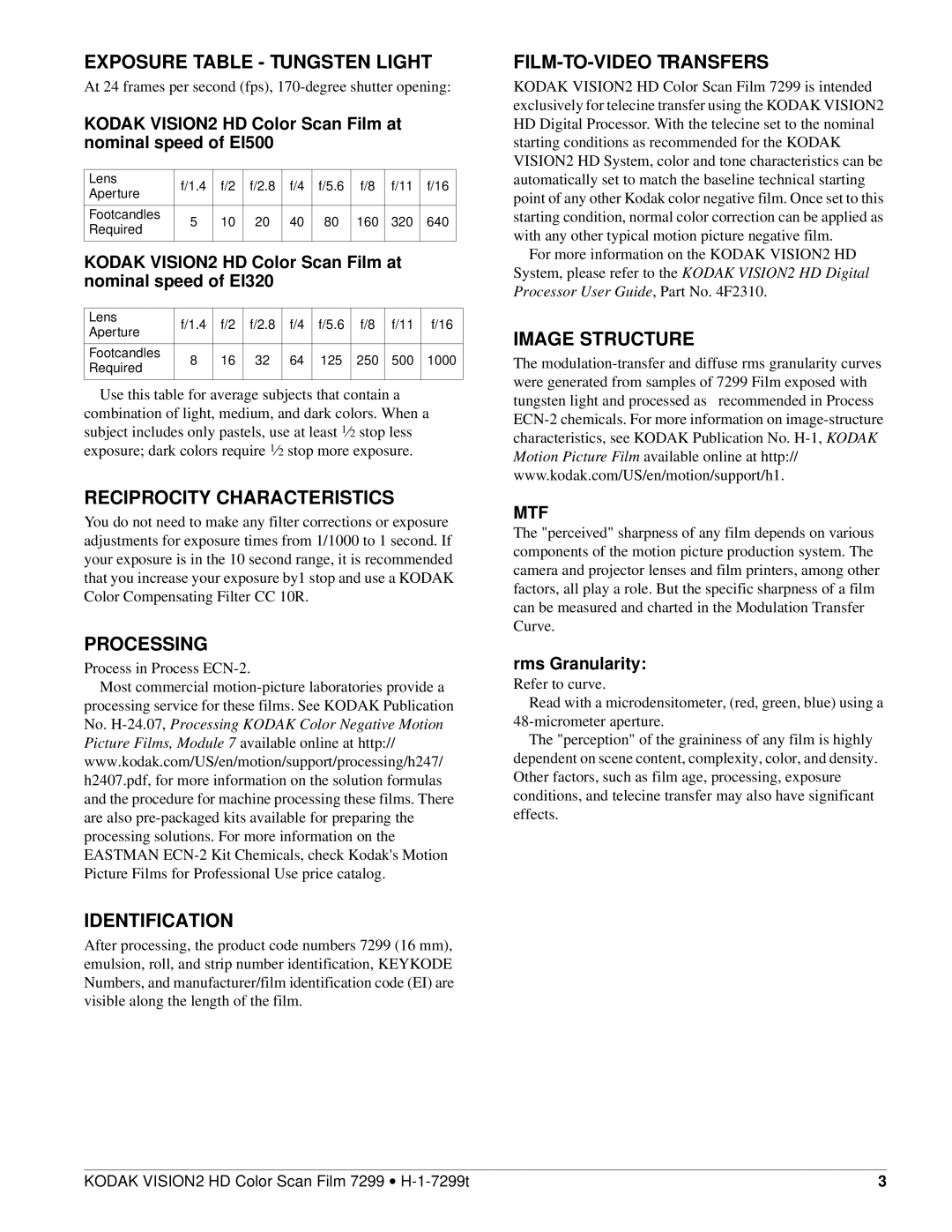EXPOSURE TABLE - TUNGSTEN LIGHT
At 24 frames per second (fps),
KODAK VISION2 HD Color Scan Film at nominal speed of EI500
Lens | f/1.4 | f/2 | f/2.8 | f/4 | f/5.6 | f/8 | f/11 | f/16 | |
Aperture | |||||||||
|
|
|
|
|
|
|
| ||
|
|
|
|
|
|
|
|
| |
Footcandles | 5 | 10 | 20 | 40 | 80 | 160 | 320 | 640 | |
Required | |||||||||
|
|
|
|
|
|
|
| ||
|
|
|
|
|
|
|
|
|
KODAK VISION2 HD Color Scan Film at nominal speed of EI320
Lens | f/1.4 | f/2 | f/2.8 | f/4 | f/5.6 | f/8 | f/11 | f/16 | |
Aperture | |||||||||
|
|
|
|
|
|
|
| ||
|
|
|
|
|
|
|
|
| |
Footcandles | 8 | 16 | 32 | 64 | 125 | 250 | 500 | 1000 | |
Required | |||||||||
|
|
|
|
|
|
|
| ||
|
|
|
|
|
|
|
|
|
Use this table for average subjects that contain a combination of light, medium, and dark colors. When a subject includes only pastels, use at least 1⁄2 stop less exposure; dark colors require 1⁄2 stop more exposure.
RECIPROCITY CHARACTERISTICS
You do not need to make any filter corrections or exposure adjustments for exposure times from 1/1000 to 1 second. If your exposure is in the 10 second range, it is recommended that you increase your exposure by1 stop and use a KODAK Color Compensating Filter CC 10R.
PROCESSING
Process in Process
Most commercial
IDENTIFICATION
After processing, the product code numbers 7299 (16 mm), emulsion, roll, and strip number identification, KEYKODE Numbers, and manufacturer/film identification code (EI) are visible along the length of the film.
FILM-TO-VIDEO TRANSFERS
KODAK VISION2 HD Color Scan Film 7299 is intended exclusively for telecine transfer using the KODAK VISION2 HD Digital Processor. With the telecine set to the nominal starting conditions as recommended for the KODAK VISION2 HD System, color and tone characteristics can be automatically set to match the baseline technical starting point of any other Kodak color negative film. Once set to this starting condition, normal color correction can be applied as with any other typical motion picture negative film.
For more information on the KODAK VISION2 HD System, please refer to the KODAK VISION2 HD Digital Processor User Guide, Part No. 4F2310.
IMAGE STRUCTURE
The
MTF
The "perceived" sharpness of any film depends on various components of the motion picture production system. The camera and projector lenses and film printers, among other factors, all play a role. But the specific sharpness of a film can be measured and charted in the Modulation Transfer Curve.
rms Granularity:
Refer to curve.
Read with a microdensitometer, (red, green, blue) using a
The "perception" of the graininess of any film is highly dependent on scene content, complexity, color, and density. Other factors, such as film age, processing, exposure conditions, and telecine transfer may also have significant effects.
KODAK VISION2 HD Color Scan Film 7299 • | 3 |
